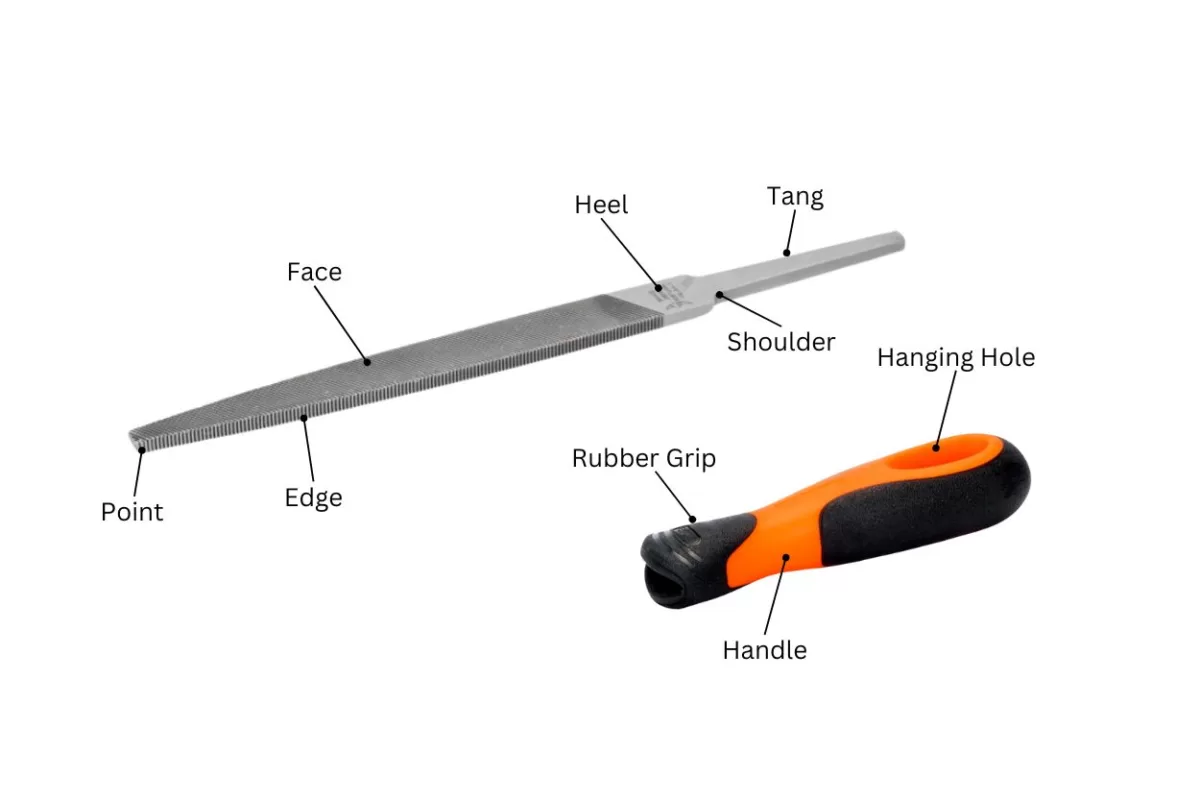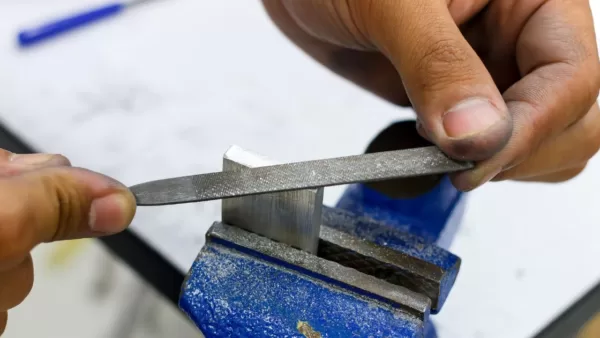What are Hand Files?
Hand Files are a manually operated tool that allow you to shape, sharpen, smooth, and trim materials with extreme control and accuracy.
Typically manufactured from hardened steel, hand files are indispensable in industries such as woodworking, manufacturing, and jewellery assembly, helping to file everything from metal and plastic to wood with ease and precision.
Parts of Hand Files
Although hand files come in different varieties, each hand file type shares several common features, including: the tang, heel, edge, face, point, back, and teeth.
Not only do these characteristics help to identify a hand file among other hand tools, each one also plays an integral part in helping the user to control and operate the file effectively.
Different Types of Hand Files
At first glance, you may not notice the subtle differences that define each type of hand file, but telling filing tools apart is easy – once you know what you’re looking for.
Different types of files are designed for different jobs, so a basic understanding of hand file types is essential when choosing which type of hand file you need.
Flat Hand Files

A flat file or flat hand file is the most common hand file type. Perfect for any kind of general hand filing, it’s easily identified by its flat surface and parallel edges.
As types of filing tools go, flat files are the most versatile, allowing you to work with both flat and concave surfaces and a range of materials.
Round Hand Files

Unlike its flat-sided cousin, round files have a distinctive conical or round shape, which starts out wider at the file handle and becomes more tapered towards the file’s point.
They are designed to help you to file circular-shaped recesses but can also be used on concave surfaces.
Three Square Hand Files

Three Square files, also known as triangular files, feature a distinctive triangular cross-section and a face that’s indented with a series of perpendicular angled lines.
They are a popular hand file cut type for sharpening edges, as well as to help make corners more defined.
Square Hand Files
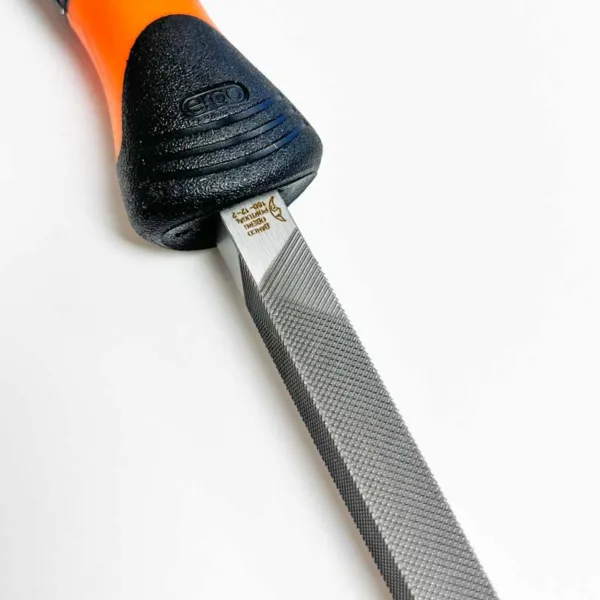
Square files are angular with four flat-sided faces and a square-shaped tip. They also feature a diamond-like texture.
This type of hand file is best suited to rectangular and square-shaped openings as well as helping to shape sharp corners.
Half Round Hand Files

Half round files look similar to a cheese grater.
They are rounded on one side, flat on the reverse side, and have rows of protruding teeth along their rounded face. They’re appropriate for both flat and curved surface types.
Needle Files
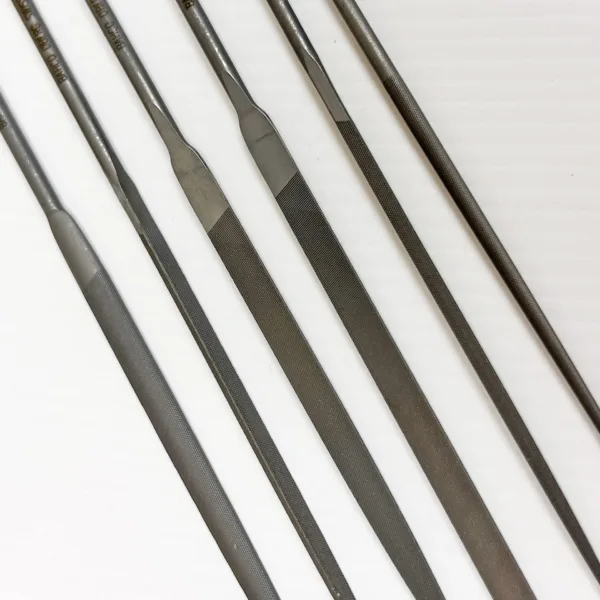
Needle files are designed for detail and precision work. They can be found in a variety of shapes, including some of the file types we’ve mentioned above.
The key difference between needle files versus other types of hand files is their size. Needle files are very small and commonly used by jewellery makers to complete intricate and fiddly filing on tiny components.
File coarseness and how to select the right file cut type
When selecting a hand file it’s important to consider coarseness and cut, as well as the file’s shape and size.
Different types of hand file feature different teeth patterns on their face. This is known as the cut. The TPI (teeth per inch) refers to the file’s coarseness, or (to put it another way) how far apart the file’s teeth are spaced.
As you might expect, cut and coarseness have an impact on the result you can achieve with a hand file, so it’s important to select the right coarseness and cut for the application.
The main hand file cut types are:

- Single cut teeth
One continuous parallel line of slanted teeth, equally spaced along the file’s face. This can produce a smooth finish with light pressure.
- Double cut teeth
Two overlapping rows of teeth, running parallel in opposite directions. Requires heavier pressure but is great for fast removal.
- Rasp cut teeth
Rows of teeth that have been created by a pointed tool (similar to a cheese grater). Primarily for softer materials such as wood, aluminium, and lead. It leaves a rough finish.
- Curved cut teeth/milled tooth
Teeth are arranged in curved contours along a rounded file face. Commonly used in the automotive industry for smoothing body panels.
Coarseness
Hand file coarseness is measured differently, depending on whether your file is American or Swiss-made.
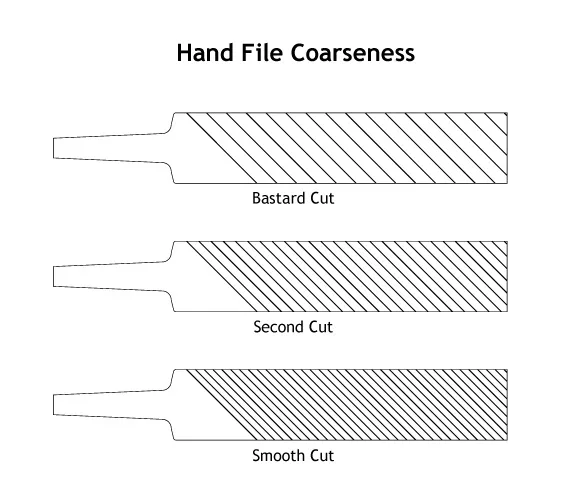
American hand files typically feature three grades of coarseness: Bastard cut, Second cut, and Smooth cut.
Swiss files, on the other hand, come in seven grades of coarseness ranging from 00 to 6. In both instances, longer files tend to have a greater degree of coarseness. This means they can remove more material, but the finish achieved is typically rough. Conversely, less coarse files produce a cleaner and more controlled finish.
How to Use a Hand file?
The standard way of operating a hand file is by grasping the point in one hand and the handle in your other. At the pointed end, position your hand so as your forefingers are gripping the file’s back and your thumb is placed on the face. The handle should sit in your palm, with your thumb and forefinger extended either side.
Ensure the object you’re filing is secured in your vice. When you’re ready, use one forward-moving motion to file, remembering to lift the file to reposition it back to the starting position. Then repeat the process, always remembering to file in one direction, whilst applying the same degree of pressure to each stroke.
If heavier strokes are needed, you should reposition your hands so as your thumb is face down on the handle and the file face is gripped along the edge, instead of at the point.
If you require lighter strokes, turn your handle-holding thumb at a right-angle and place your fingers and the thumb of your other hand on top of the file’s face.
Your vice should be positioned at elbow height for normal filing, a little lower down for heavy filing, and at eye level for delicate filing.
Files for Metalworking
The best hand files for metalworking are those which have a high TPI and a coarse cut. Here are some of our top picks for metalwork hand files:

BAHCO 4-153-08-1-2
ERGO™ HOMEOWNER’S FILES WITH TWO-COMPONENT HANDLE FOR METALWORK
Files for Woodwork
If you’re filing wood, you should opt for a hand file that has a rasp cut. Some ideal hand files for woodwork include:

BAHCO 4-154-08-2-2
4-IN-2 ERGO™ HOMEOWNER’S FILE SET WITH TWO-COMPONENT HANDLE FOR WOOD AND METAL
Hand Files for Plastic
Hand files suitable for plastic filing fall into two camps. For harder, more abrasive plastics, you’ll need a file that has a high TPI and sharp teeth. For softer plastics, we recommend a finer tooth, such as a single cut. Check out our top-performing hand files for plastic:

FACOM DRD.B250EMA
HALF-ROUND BASTARD FILES WITH HANDLE DESIGNED FOR WOOD AND METAL & HARD PLASTIC
With or without handle: Which file is best to use?
Many different types of hand file are sold without a handle, while some models, such as needle files, occasionally have a pre-forged handle in place of the tang.
The rationale behind this is that files often wear quicker than their handles, and it’s cheaper to replace an old blunt file for new rather than have its teeth re-sharpened.
With the exception of hand files with pre-forged handles, the tang of a file is purpose- designed to fit into a removable handle, thus its narrow, elongated, shape that tapers into a blunt point. Attempting to operate the file by holding onto the tang offers you less grip and consequently less control. You also risk injuring your hand, so it’s widely advised to invest in a removable ergonomic handle that fits with your file.
Popular Hand File Sets
Ready to upgrade your hand file or expand your filing tool kit? Take a look at our extensive range of high-performing hand file sets from top tool brands. From metalwork files to files for woodwork, whatever material you need to file, we have the right tool for the job.
Ready to get organised?
Find your perfect tool storage from our professional range
From tool bags and tool chests to tool boxes with wheels, tool belts, tool cases, and trade-specific tool storage, at Red Box Tools we offer high-quality solutions you can count on.
Or why not take your tool storage to the next level with our made-to-order tool box foam drawer inserts and custom shadow foaming?




